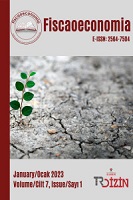Türkiye İhracatının Rekabet Gücünü Etkileyen Faktörler: Ekonometrik Bir Analiz (2001-2019)
Factors Affecting the Competitiveness of Turkish Exports: An Econometric Analysis (2001-2019)
Author(s): Hakkı ÖZBAŞ, Oğuz YILDIRIMSubject(s): National Economy, Business Economy / Management, Economic history, Economic policy, Socio-Economic Research
Published by: Ahmet Arif Eren
Keywords: Competitiveness; Export; ARDL Bounds Test; Toda-Yamamoto Causality Analysis;
Summary/Abstract: The aim of the study is to determine the effects of the factors that are likely to affect the export levels of the goods determined to be in an advantageous position in Turkey's competition and therefore, its competitiveness on export demand. In this context, the variables used to predict the export demand function in the econometric analysis are; real exports, human capital, relative export price, real exchange rate, gross fixed capital investments and foreign country income. For the period covering the years 2001-2019, ARDL boundary test and TodaYamamoto causality analyzes were performed to determine the relationships between exports and explanatory variables. The estimation of real exports was realized by creating two different groups of goods. While one of the goods groups was obtained from the total export amounts of the goods with positive competitiveness that Turkey exports the most (XEY) ("Knitted clothing and accessories," "Unknitted clothing and accessories," "Iron or steel goods," and "Motor land vehicles, tractors, bicycles, motorcycles and other land vehicles, their parts, parts, accessories") and the other is the total export of the goods that increased Turkey's competitiveness the most from 2001 to 2019 (XYR) "Floor coverings from carpets and other weaving materials," "Milling products, malt, starch, inulin, wheat gluten," "Miscellaneous manufactured goods (hygienic towels, diapers, pens, lighters, zippers, and brushes, etc.)," "Grain, flour, starch or dairy preparations, pastry products," "Waddling, felt and nonwoven textiles mensucat, special yarns, twine, cord, rope, rope and articles made of them," "Knitted goods" and "Weapons and ammunition, their parts, sections parts and accessories.") As a result of the research, it was seen that the most important factor in terms of both long-term relationship and causality relationship for the two export groups was human capital. In addition, it was found that the real exchange rate affected the two export groups in the long term and it was concluded that the effects of the explanatory variables of foreign income level, gross fixed capital investment and relative export price and causality relations differed in terms of the two groups of goods formed.
Journal: Fiscaoeconomia
- Issue Year: 7/2023
- Issue No: 1
- Page Range: 606-643
- Page Count: 37
- Language: Turkish

